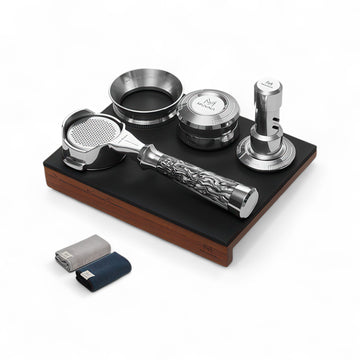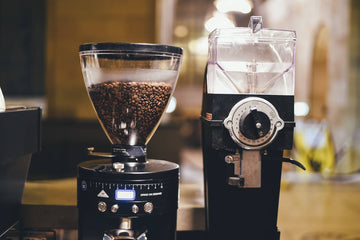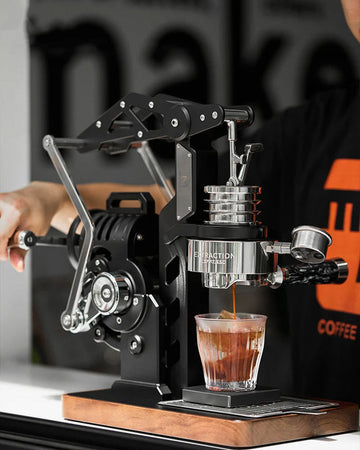Selecting the true coffee to make is a huge decision. You own a variety of styles and price points to pick. Which could be best for you and others? (your families, your friends, your patrons). This handy guide will help you know how to dial in the grinder in your shots. Develop the coffee with your grinder and keep it running outstanding into the future.
What is dialing?
Getting the right grind size when making the coffee is dialing. To rotate your grind size, you need to estimate the time of pulling a provided liquid volume. Then, you adjust the grind size. You aim to generate a double shot in a few seconds, between the first drip and portafilter spouts.
Before kicking off, ensure that your coffee maker is totally warmed up and the portafilter locked in place. A justly dialed-in coffee grinder using the right amount of coffee is the primary way to make a great coffee cup.
What is adjustment?
The way you adjust the grinder to grind coffee (coarse or fine). To make the right coffee taste, you should fine-tune the grinder to grind the coffee more coarsely or more finely. Coffee will counter the environment, so you probably change something throughout the day to keep your coffee shot tasting amazing. For those reasons, you need to weigh and check the time in every brewing shot.
What is dose?
The amount of coffee that is made on the debut of the coffee grinder. When set the grinder correctly, your grinder will provide you a dose of 18-gram coffee. This is the reason you need to weigh each dose to ensure that you are using the proper amount of coffee in your coffee shot.
How to dial your coffee in a grinder
Step 1: plug in the grinder, install the hopper, and open the hopper gate
The first step is an obvious thing to do but several folks tend to put coffee in the hopper and do not pull out the tab. The little tab is useful if you remove the hopper with coffee. In case you are using a single-dosing grinder, this will not be applicable.
Step 2: take into account your method and eliminate the fickle of quantity
The most common methods are single-dosing timed dosing and weight-based dosing. The coffee grinder will be optimized for one of these ways. Nevertheless, some could be also flexible. Some grinders, for instance, are time-based but they could become single-dose.
Use a scale that might grind a half gram so that you can recognize how much coffee flows to a portafilter and how much coffee liquid will come out. A good scale may scale a tenth of a gram. It is also water-resistant and it has lightning-fast readings. Thus, you do not have to spend an alarm and a leg on a scale.
A lot of modern grinder give you the option of timed grinding, so you should set a grind time in advance. This is because the amount of coffee will dispense to the portafilter with ease.
Step 3: grinding your coffee
Before altering, try your grinder’s factory setting. If you see nothing come out, follow another solution. Remove the scale (if available) with an empty portafilter on top. Then, set the grind time to dispense the desired amount of coffee or grind till you get the quantity.
Check your dose. It will have 18 grams (double dose) or 20 grams of coffee (triple dose). If you are aware of the dose adjustments by a gram or two, a grind setting will be affected. The shots could speed up or slow down. The scale will help you make a good routine until you are confident in verifying the dose.
Step 4: pull your first shot
When grinding the first shot or using timed dosing, the first grind will be good or bad. This is normal, so forget it and toss the first coffee shot if it will not reach your desired dose.
Ensure the portafilter basket is dry and clean enough. Then, make small adjustments to make sure that the coffee bed is completely distributed after grinding the portafilter. Use a distribution tool (like a WDT device) or your index finger. Sweep the coffee up, down, left, and right. Balance the tamper and apply the medium pressure.
Firmness is more important than the exact force. Begin with your shot and your shot timer at the same time. Then, check the time to get from 25 to 40 grams of liquid yield. The total shot time will be between 25 and 35 seconds, kicking off when the pump is activated.
Step 5: dial in your grind
If a shot takes less than 25 seconds, the grind will be adjusted better. Hold your dry dose in the similar portafilter. Remain as many variations as possible and doing a tweak at a time is key. You should alter coarser if the shot has more than 40 seconds.
It is crucial to adjust the shot and bear in mind that changes do not instantly impact. There will be some coffee kept inside from your last shot that needs to be removed. Whichever kind of grinder you own, please keep in mind that experimenting will support your coffee grind becoming spontaneous.
Keep your scale handy and notice how much the adjustment turns to the shot time. When the shots come to 25 or 35 second, you can make small changes to remain in the range.
Tips for dialing in the accurate grind
- Change one method at the time: once you are aware of a step in your coffee routine might affect your finished cups. However, every other step of the brew method keeps the same. In this case, the grind size varies. Water temperature (from 195℉ to 205℉), coffee dose, and technique should be steady from cups to cups.
- Kick off the setting that you last used: in case your grinder is new, fine-tune the middle setting will be a good option to start. The blades could be sharp, so a new grinder possibly takes a lot of trials than an old one. If you have already owned a grinder, make the cup at the setting you last used. Remember that you use old beans when first dialing in the grinder.
- Keep the diversity between grind settings small: after you have brewed a cup (as the baseline setting), you should grind the coffee for more cups. The one will be slightly finer and another could be slightly coarser than the baseline cup. Minor deviations make big differences, so alter the grind setting by only one or two steps on the grinder.
- Recognize your preferences: before tasting your coffee shot, take little time to realize your taste preferences. If you love dark-roasted blends, then you will prefer bitter coffee shots.
- Taste your coffee and notice the flavor in your mouth: pay close attention to the coffee’s flavors stay in your mouth. If you feel unpleasant sour and the taste reaches at the sides of both your mouth and tongue, the coffee will be under-extracted and the grounds are coarse.
- Check another batch if you did not get the true coffee taste: in case you cannot get the right coffee taste, do not be panicked. You should try and verify new batches.
FAQs
What does dialing in beans mean?
Changing the grind setting on the coffee grinder is dialing in beans.
What happens if the coffee grind is too fine?
If you grind the coffee too fine, your coffee will be over-extracted. The taste will be bitter and muddy.
How do you adjust a grinder?
Most commercial coffee grinders often rotate the collar clockwise, making the coffee grind finer. The collars on these coffee grinders will be locked.
Final words
Do not be frightened of the coffee grind. This task will take practice and patience, so you need to waste lots of coffee doing it. Some grinders tend to be sensitive. If you understand how your coffee beans are high-quality and how to dial in the grinder, you will see the positive effect on the coffee grinder.













